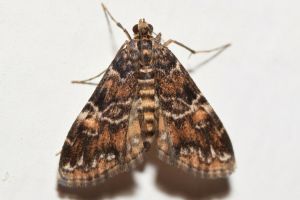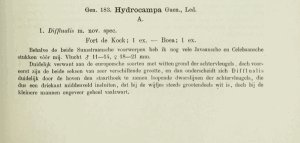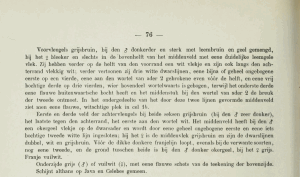

 +6Kontinente:EUAS
+6Kontinente:EUAS1. Lebendfotos
1.1. Falter
2. Diagnose
2.1. Erstbeschreibung
3. Biologie
3.1. Nahrung der Raupe
- [Hydrocharitaceae:] Vallisneria sp. ? (Wasserschraube ?)
- [Acanthaceae:] Hygrophila sp. ? [= Synnema sp. ?] (Wasserwedel ?)
- [Alismataceae:] Echinodorus sp. ? (Schwertpflanze ?)
- [Potamogetonaceae:] Potamogeton sp. ? (Laichkraut ?)
- [Marsileaceae:] Marsilea sp. ? (Kleefarn ?)
Goater (1986) stellt zur Raupe zusammen: "When young, inhabits a tight spinning among leaves of pondweeds (e.g., Vallisneria, Synnema, Echinodorus, Potamogeton, Marsilea), later living in a floating case made of leaf-fragments." Was die Raupen hier wirklich fressen, ist wohl nicht ganz klar.
(Autor: Erwin Rennwald)
4. Weitere Informationen
4.1. Andere Kombinationen
- Hydrocampa difflualis Snellen, [1880] [Originalkombination]
4.2. Synonyme
- Isopteryx enixalis Swinhoe, 1885
- Cymoriza linealis Moore, 1888
- Nymphula osculatrix Meyrick, 1933
4.3. Verbreitung
Goater (1986) stellt für England zusammen: "E. difflualis was first discovered in Britain in 1977, in aquatic nurseries at Enfield, Middlesex, which have since proved a rich hunting-ground for These Tropical nymphulines. E. difflualis is a native of the Far East, where it is widespread. In greenhouses, the moth rests head downwards with Abdomen raised and wings arranged 'tent fashion' over the body. At Enfield, it has been by far the commonest species recorded." Doch die Art blieb nicht auf England beschränkt. Goater et al. (2005) informieren: "So far found in nurseries in Great Britain (Agassiz, 1978: 118), Denmark (Agassiz, 1981: 22), the Netherlands (Kuchlein & de Vos, 1999) and Finland (Karvonen et al., 1980). Native to the Oriental Region."
Agassiz et al. (2013: 112) führen die Art bei den "adventive species" und schreiben zu England: "Occasionally imported with aquatic plants, only survives in heated greenhouses. Asian."
Wenn sich die Art trotz dieser Ausgangsbasis noch nicht in Westeuropa etabliert hat, dann kann sie es wohl aus klimatischen Gründen nicht.
(Autor: Erwin Rennwald)
4.4. Literatur
- Agassiz, D.J.L., Beavan, S.D. & R.J. Heckford (2013): Checklist of the Lepidoptera of the British Isles. - Royal Entomological Society. 206pp.
- Goater, B. (1986): British Pyralid Moths. A guide to their identification. — 1-175 + 8 colour plates (Colchester: Harley Books).
- Goater, B., Nuss, M. & Speidel, W. (2005): Pyraloidea I (Crambidae: Acentropinae, Evergestinae, Heliothelinae, Schoenobiinae, Scopariinae). - In: Huemer, P. & Karsholt, O. (Hrsg.): Microlepidoptera of Europe 4: 1-304.
- Erstbeschreibung: Snellen, P. C. T. (1880): Systematische lijst met beschrijving der niewe soorten en aanteekeningen over sommige reeds bekende. — In: Veth, P. J. (1880) [„1892“]: Midden-Sumatra. Reizen en oderzoekingen der Sumatra-expeditie, uitgerust door he aardrijkskundig genootschap, 1877-1879. Vierde Deel. Natuurlijke historie. Eerste gedeelte. Fauna. Laatste Helft. Achtste afdeeling: 10-92, pl. I-V. Leiden (E. J. Brill).










